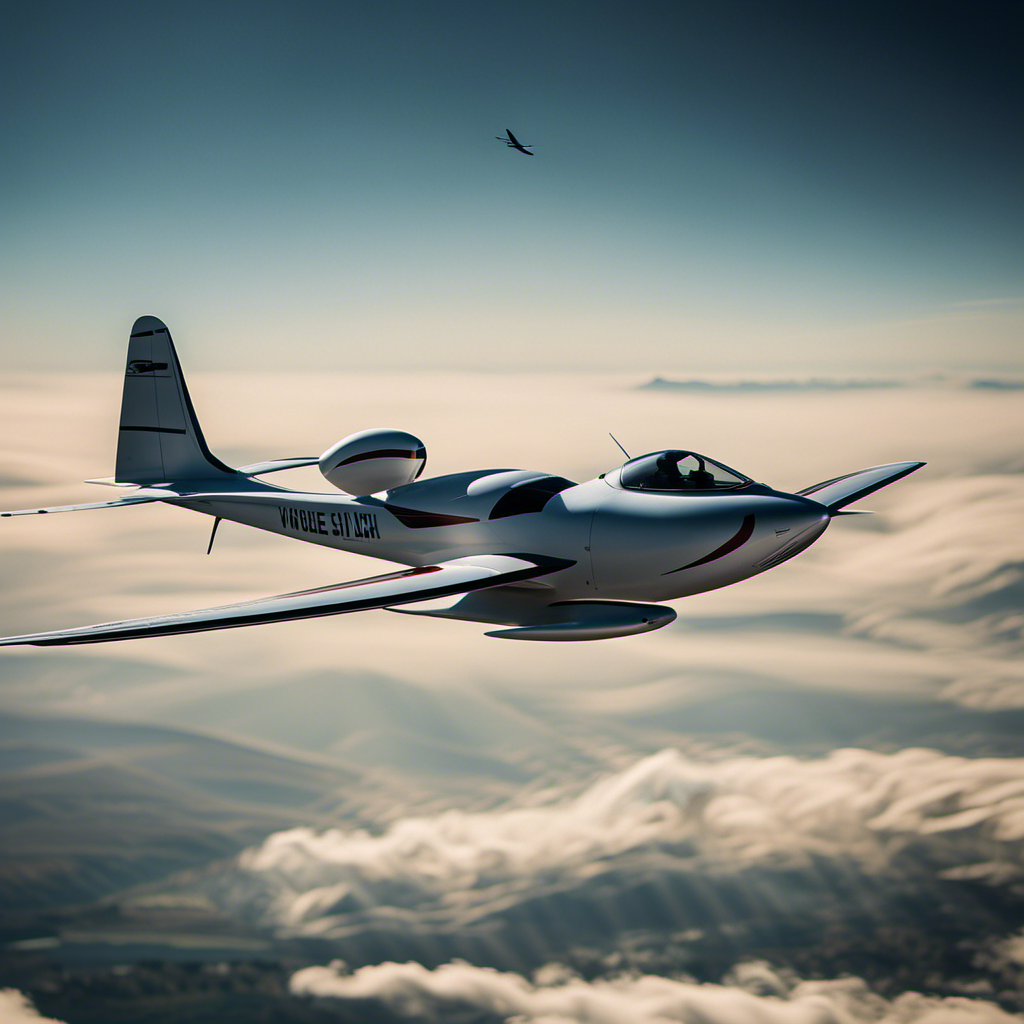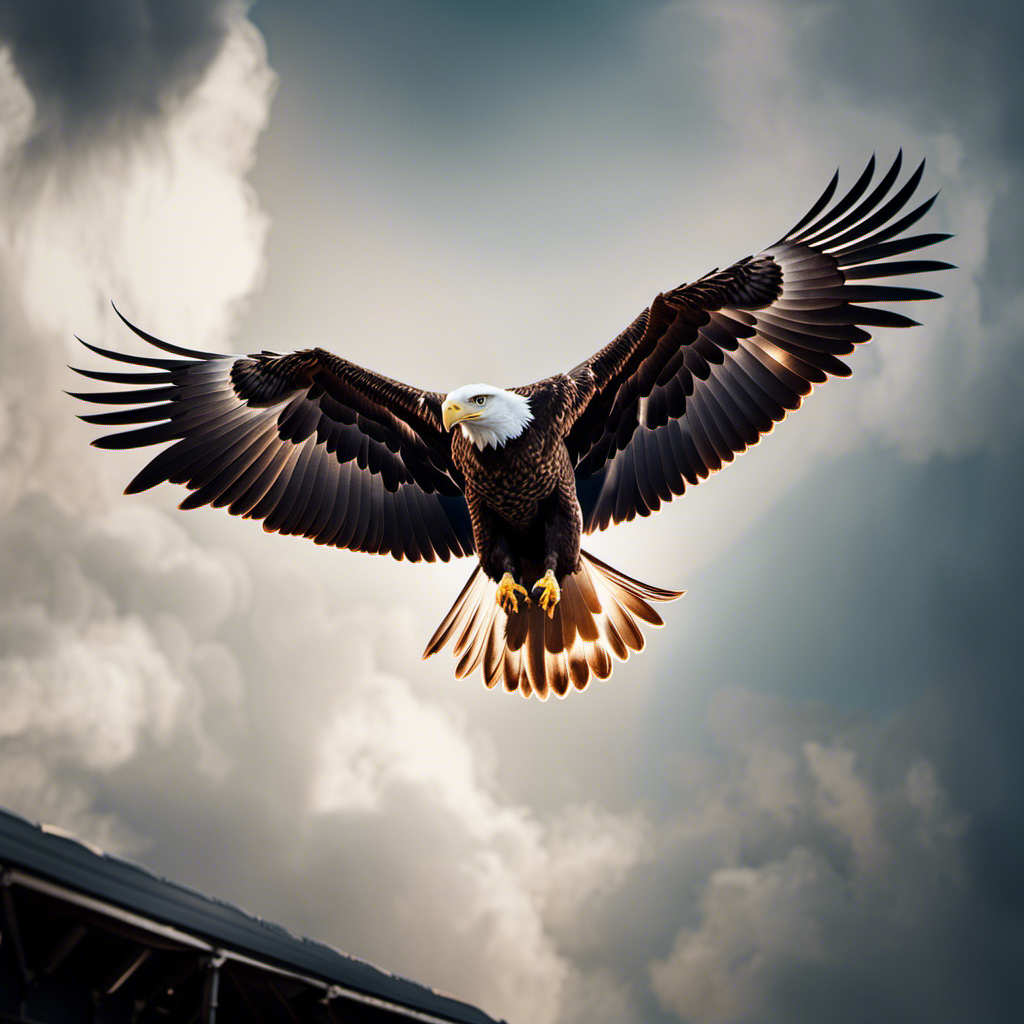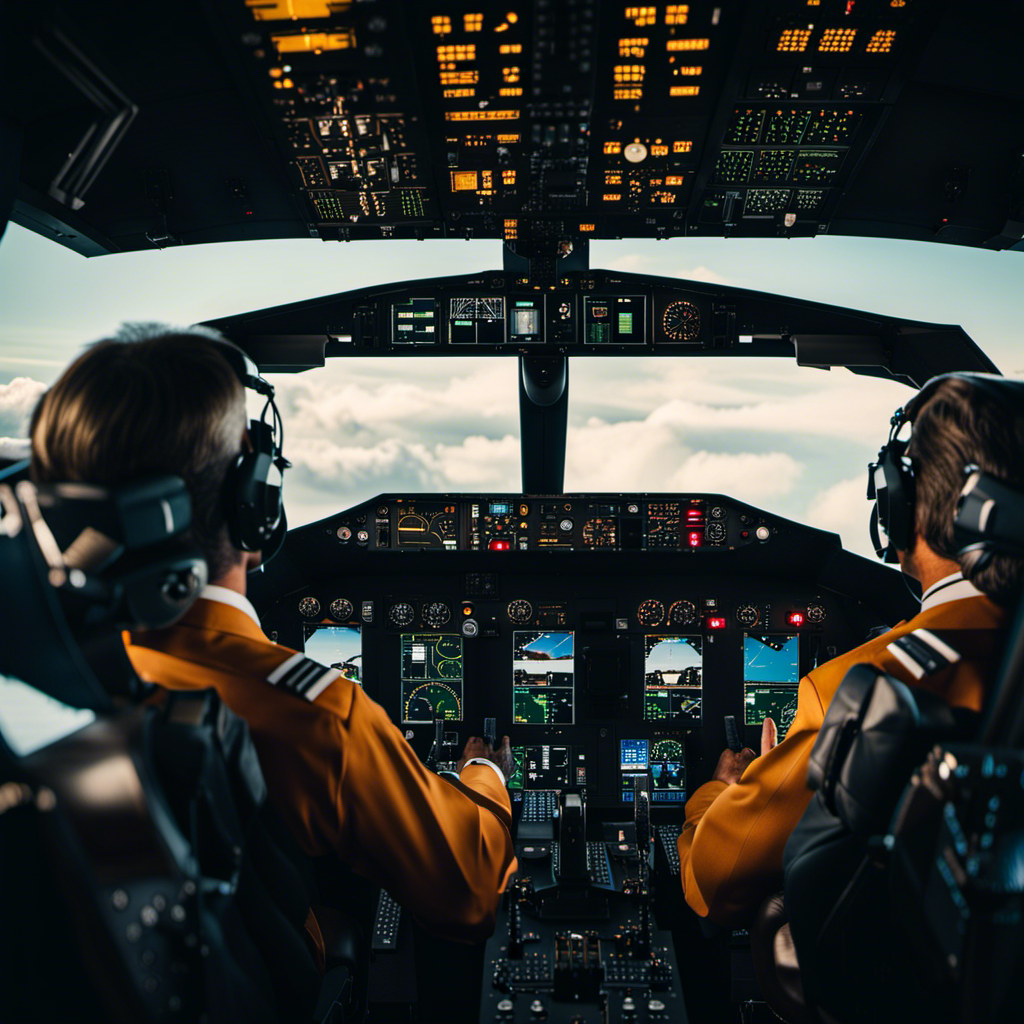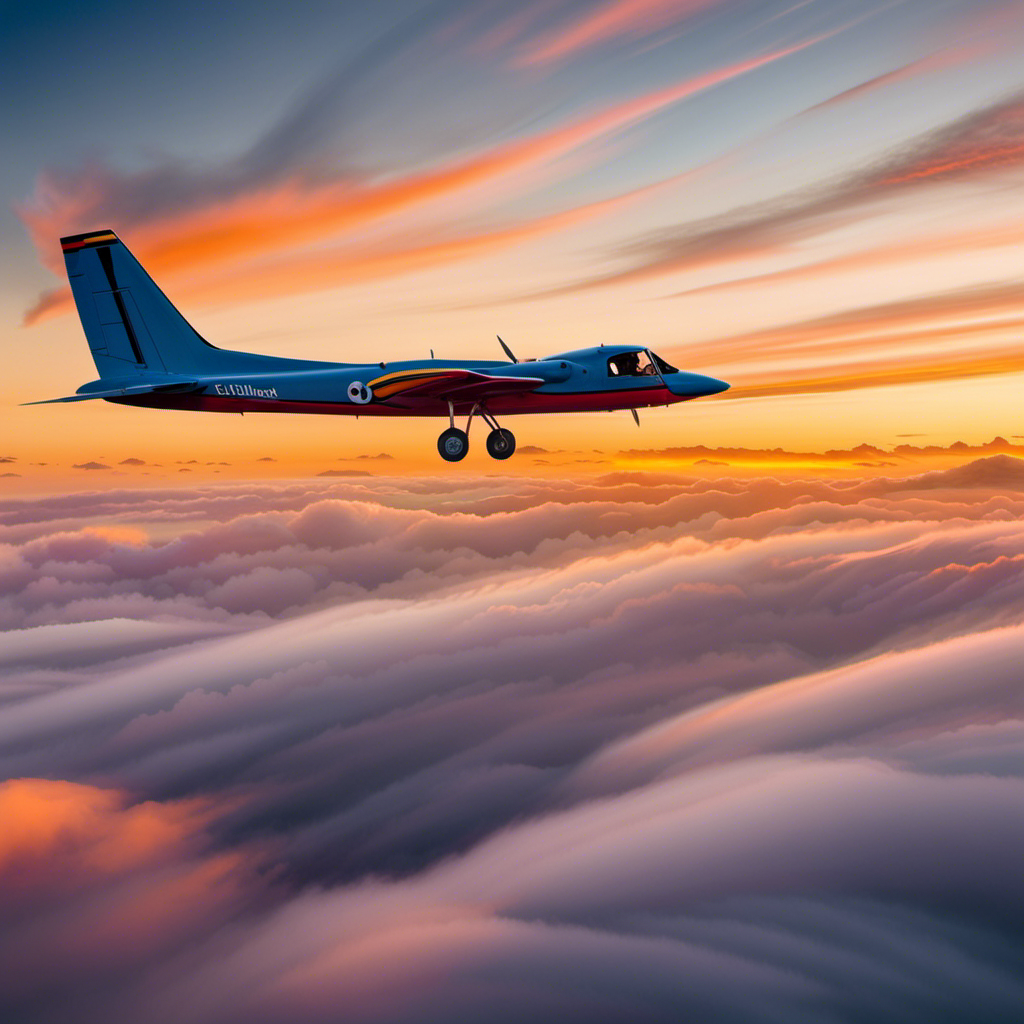As an aviation enthusiast, I often ponder over the classic dilemma of choosing between a glider and a powered aircraft. Both options have their own advantages and drawbacks, making the decision quite intricate.
In this article, we’ll take a comprehensive look at the pros and cons of both options, examining factors such as cost, flying experience, environmental impact, accessibility, weather considerations, and maintenance.
By weighing these factors against our personal preferences and future goals, we can make an informed choice that suits our individual needs.
So, let’s dive in and explore the fascinating world of gliders and powered planes!
Key Takeaways
- Gliders are more affordable and have lower operating costs compared to powered planes.
- Gliders offer a serene and silent flight experience, while powered planes provide a thrilling and dynamic flight experience.
- Gliders have a minimal environmental impact, while powered planes have a higher environmental impact.
- Powered planes have more accessibility with airports and runways and can operate in a wider range of weather conditions.
Types of Gliders
If you’re looking for a thrilling and eco-friendly flying experience, gliders are the way to go. Gliders are aircraft that are designed to fly without an engine. They rely solely on the forces of nature to stay aloft.
One of the most exciting aspects of gliders is the competitive sport of glider competitions. These events showcase the incredible capabilities of these aircraft and the skills of the pilots. Glider competitions involve various challenges such as distance flying, speed tasks, and accuracy landings. Pilots compete against each other to demonstrate their mastery of glider flying techniques.
In addition to glider competitions, glider aerobatics is another exciting aspect of glider flying. Glider aerobatics involve performing a series of maneuvers in the air, such as loops, rolls, and spins. These maneuvers require precise control and coordination, as well as a deep understanding of the aerodynamics of the glider. Glider aerobatics can be both thrilling to watch and exhilarating to experience as a pilot.
Transitioning to the subsequent section about types of powered planes, it’s important to note that while gliders offer a unique and eco-friendly flying experience, there are also different types of powered planes that provide their own advantages and capabilities.
Types of Powered Planes
There’s a wide variety of options when it comes to choosing the type of plane. When considering powered planes, there are several factors to take into account.
First, there’s the choice between single-engine and multi-engine planes. Single-engine planes tend to be more affordable and have lower maintenance costs. They are also easier to handle for beginners and provide a more intimate flying experience. On the other hand, multi-engine planes offer increased performance and redundancy, making them more suitable for longer flights and professional pilots.
Another important consideration is the type of propulsion system. Piston-powered planes are the most common and cost-effective option. They are reliable and relatively easy to maintain. However, turbine-powered planes provide a higher level of power and speed, making them ideal for long-distance flights and commercial applications. They do come with a higher cost of operation and maintenance though.
Overall, the choice of powered plane will depend on one’s budget, flying experience, and specific needs. It’s important to carefully weigh the pros and cons of each type, considering factors such as cost comparison and the desired flying experience.
Now that we’ve covered the types of powered planes, let’s move on to the next section where we will dive deeper into the cost comparison aspect.
Cost Comparison
To make an informed decision about which type of powered plane is right for you, it’s important to carefully compare the costs associated with each option. Here is a cost analysis and affordability comparison to help you in your decision-making process:
-
Initial Purchase Cost: When considering the cost of a powered plane, you need to factor in the initial purchase price. Gliders tend to be more affordable compared to powered planes, as they don’t require an engine or fuel system.
-
Operating Costs: Powered planes typically have higher operating costs due to the need for fuel and maintenance of the engine. Gliders, on the other hand, have lower operating costs as they rely on natural air currents for flight.
-
Fuel Expenses: Powered planes consume fuel during each flight, which can add up over time. Gliders, being fuel-free, offer a significant advantage in terms of cost savings in this area.
-
Maintenance and Repairs: Powered planes require regular maintenance and occasional repairs, which can be costly. Gliders, on the other hand, have fewer mechanical components and are generally less expensive to maintain.
Considering these factors, it becomes clear that gliders offer a more affordable option in terms of cost analysis. However, cost is just one aspect to consider when choosing between a glider and a powered plane.
Now, let’s delve into the next section and explore the flying experience.
Flying Experience
When comparing the flying experience of gliders and powered planes, there are three key points to consider:
-
The serenity and silence of gliders: Gliders offer a serene and silent flight experience, allowing the pilot to fully immerse themselves in the beauty of the surroundings without the noise and vibration of an engine.
-
The thrill and control of powered planes: On the other hand, powered planes provide a thrilling experience with the ability to control the aircraft and perform maneuvers.
-
Passenger comfort and safety: Additionally, passenger comfort and safety are crucial factors to consider, as both gliders and powered planes must ensure a comfortable and secure journey for passengers.
Serenity and Silence of Gliders
The serenity and silence of gliders make them a peaceful and tranquil way to soar through the sky. As a pilot, I have experienced firsthand the serenity that comes with gliding. The absence of an engine noise allows for a truly immersive experience, where one can appreciate the beauty of nature without any distractions. The table below highlights the key aspects of the serenity and silence of gliders:
| Serenity | Silence |
|---|---|
| Calming | Peaceful |
| Tranquil | Quiet |
| Relaxing | Serene |
| Meditative | Silent |
Transitioning into the next section, the thrill and control of powered planes offers a completely different experience.
Thrill and Control of Powered Planes
Experiencing the thrill and control of flying a powered plane can be an exhilarating and empowering experience. As I take the controls, the rush of adrenaline courses through my veins, knowing that I have the power to soar through the skies. Here are some key aspects that make flying a powered plane an exciting adventure:
-
Speed: Powered planes offer the ability to reach incredible speeds, allowing for a faster and more dynamic flight experience.
-
Maneuverability: With the use of engine power, I have greater control over the aircraft’s movements, enabling precise turns, climbs, and descents.
-
Altitude: Powered planes can ascend to higher altitudes, providing breathtaking views and the opportunity to navigate through different layers of the atmosphere.
-
Aerobatics: Unlike gliders, powered planes allow for thrilling aerobatic maneuvers such as loops, rolls, and spins, adding an extra level of excitement to the flight.
As I transition into the next section about passenger comfort and safety, it is important to consider the trade-offs that come with the thrill of flying a powered plane.
Passenger Comfort and Safety
Passenger comfort and safety are important considerations when flying in a powered plane. As an aviation expert, I understand the significance of ensuring passenger satisfaction and implementing effective emergency procedures. To analyze this further, let’s examine a table that illustrates the key aspects of passenger comfort and safety in a powered plane:
| Aspect | Importance | Explanation |
|---|---|---|
| Seat comfort | High | Comfortable seats enhance passenger experience and reduce fatigue during long flights. |
| Cabin air quality | Medium | Clean and well-ventilated air is crucial for preventing the spread of airborne illnesses. |
| Emergency exits | Critical | Adequate and easily accessible emergency exits are vital for passenger evacuation in case of an emergency. |
| Safety demonstrations | High | Proper safety demonstrations equip passengers with knowledge on emergency procedures and protocols. |
Understanding these aspects allows airlines to prioritize passenger satisfaction and ensure safe travel. However, it is important to also consider the environmental impact of powered planes. Transitioning into the subsequent section, we will explore the environmental implications of choosing a powered plane.
Environmental Impact
When considering the environmental impact, it’s important to weigh the pros and cons of choosing a glider or powered plane. Both options have their advantages and drawbacks in terms of their carbon footprint and noise pollution. Here are some key points to consider:
-
Carbon Footprint: Gliders have a significantly lower carbon footprint compared to powered planes. Since gliders rely on natural air currents for propulsion, they don’t produce any emissions during flight. On the other hand, powered planes use fossil fuels, resulting in higher carbon dioxide emissions.
-
Noise Pollution: Gliders are almost silent, making them an excellent choice for minimizing noise pollution. Their quiet nature allows for a more peaceful flying experience and reduces disturbances to wildlife and nearby communities. Powered planes, however, generate noise due to their engines, which can be a concern in residential areas and natural habitats.
-
Energy Efficiency: Gliders are highly energy-efficient as they harness the power of the atmosphere to maintain flight. They require minimal energy input to stay airborne, resulting in lower overall energy consumption. Powered planes, on the other hand, rely on engines that consume fuel continuously, making them less efficient.
-
Range and Flexibility: Powered planes offer greater range and flexibility compared to gliders. With an engine, powered planes can travel longer distances, reach higher altitudes, and maneuver more easily. Gliders, on the other hand, are limited by the availability of suitable air currents and are generally more restricted in their flight capabilities.
-
Infrastructure Requirements: Powered planes rely on airports with runways and fueling stations, requiring more extensive infrastructure. Gliders, on the other hand, can take off and land on smaller airfields or even grassy fields, reducing the need for specialized infrastructure.
Considering these factors, it’s clear that gliders have a lower environmental impact in terms of carbon footprint and noise pollution. However, powered planes offer greater range and flexibility.
Transitioning to the subsequent section about training and licensing, it is important to understand the requirements for operating both gliders and powered planes without compromising safety and efficiency.
Training and Licensing
Transitioning from the environmental impact of glider and powered planes, let’s delve into the important aspects of training and licensing in aviation. When it comes to operating any aircraft, thorough training is paramount to ensure safety and proficiency.
Training methods for both glider and powered planes involve a combination of theoretical knowledge and practical experience. Aspiring pilots undergo ground school, where they learn about aerodynamics, meteorology, navigation, and regulations. Additionally, they receive hands-on training in simulators and actual aircraft to develop essential skills such as takeoff, landing, and emergency procedures.
Licensing requirements vary depending on the type of aircraft. For glider pilots, a Private Pilot License (PPL) is typically required, which involves a minimum number of flight hours and successful completion of written and practical exams. Powered plane pilots, on the other hand, must obtain a Private Pilot License (PPL) or a Commercial Pilot License (CPL), depending on their career aspirations. These licenses involve more extensive training and additional requirements, such as instrument flying and night flying.
Transitioning into the subsequent section about accessibility, it is crucial to consider the factors that influence the availability and ease of access to training and licensing opportunities.
Accessibility
When considering the accessibility of flying, several key points come to mind: the availability of gliding clubs, access to powered plane airports, and geographic limitations.
Gliding clubs play a crucial role in providing training and flying opportunities for enthusiasts, allowing them to learn and practice their skills in a controlled environment.
On the other hand, access to powered plane airports is essential for those interested in pursuing powered flight, as it provides the necessary infrastructure and resources.
However, geographic limitations can pose challenges, as certain areas may have limited options for gliding clubs or powered plane airports, making it more difficult for individuals to engage in these activities.
Availability of Gliding Clubs
If you’re considering joining a gliding club, you’ll find that there are many options available to you. Gliding clubs provide a great opportunity to engage in gliding competitions and enhance your flying skills. Additionally, these clubs offer glider storage facilities, ensuring the safety and maintenance of your glider. To emphasize the benefits of joining a gliding club, consider the following table:
| Gliding Club Options | Gliding Competitions | Glider Storage |
|---|---|---|
| Local Club A | Regular competitions | Hangar space |
| Regional Club B | National championships | Trailer parking |
| National Club C | International events | Private hangar |
Joining a gliding club not only allows you to participate in thrilling gliding competitions but also provides secure glider storage options. Now, let’s discuss another aspect of glider accessibility: access to powered plane airports.
Access to Powered Plane Airports
You’ll find that accessing powered plane airports is a convenient option for glider pilots looking to travel longer distances or explore new areas.
Glider pilots have inherent distance limitations due to their lack of an engine, which restricts their ability to cover large distances. However, by utilizing powered plane airports, glider pilots can overcome these limitations.
Access to powered plane airports allows glider pilots to tow their gliders to higher altitudes, where they can then release and begin their soaring journey. This method significantly increases the range and distance that glider pilots can achieve. They can now travel to distant locations and explore new areas without the constraints of their glider’s limited endurance.
With access to powered plane airports, glider pilots can truly expand their horizons and enjoy the freedom of long-distance gliding.
As we transition into the next section on geographic limitations, it’s important to consider how the availability of suitable soaring conditions and landing sites can impact a glider pilot’s choice of location.
Geographic Limitations
To overcome geographic limitations, I explore areas with favorable weather conditions and suitable landing sites for glider pilots. Geographic restrictions can pose challenges for glider pilots, as they rely on natural uplift sources and need sufficient landing options.
When selecting an area, it is important to consider factors such as wind patterns, thermals, and the presence of ridges or mountains that can create lift. It is also crucial to have access to landing sites, such as open fields or airports, where gliders can safely touch down.
By carefully assessing these factors, I can identify areas that offer the best conditions and landing options for glider flights.
Now, let’s delve into the next section and discuss the important weather considerations for glider pilots.
Weather Considerations
When deciding between a glider and a powered plane, consider the weather conditions you’ll be flying in. Weather plays a crucial role in determining the type of aircraft that is suitable for your flight. Here are some key points to consider:
-
Wind Speed: Gliders are more affected by wind speed than powered planes due to their lack of engine power. Strong winds can make it difficult for gliders to take off or maintain altitude, whereas powered planes are more equipped to handle these conditions.
-
Thermal Activity: Gliders thrive in thermals, which are rising columns of warm air. If you are flying in an area with strong thermals, a glider would be a great choice as it can ride these updrafts and stay airborne for longer periods.
-
Precipitation: Gliders are not equipped to handle rain, snow, or other forms of precipitation. Powered planes, on the other hand, have the advantage of being able to fly in various weather conditions, including light rain or snow.
-
Visibility: Gliders require good visibility to safely navigate and land. Poor visibility due to fog or heavy rain can significantly impact a glider’s performance and safety.
Considering these weather-related factors, it is important to assess your flying conditions and choose the aircraft that best suits the weather conditions you will encounter.
Now let’s transition into discussing the maintenance and upkeep of these aircraft.
Maintenance and Upkeep
Considering the weather conditions you’ll be flying in, it’s important to understand the maintenance and upkeep required for your aircraft. When it comes to gliders, the cost of maintenance is generally lower compared to powered planes. Gliders have fewer moving parts and no engine, which means there are fewer components that could malfunction or require regular servicing. This translates to lower maintenance costs and less time spent on upkeep.
In terms of the lifespan of gliders, with proper maintenance and care, they can last for many years. The structural integrity of a glider largely depends on the quality of the materials used and the attention given to regular inspections. Regular inspections and maintenance routines are crucial to ensure that the glider remains airworthy and safe to fly.
Transitioning to the next section about personal preference and future goals, it is important to consider not only the maintenance and upkeep requirements but also your own preferences and aspirations as a pilot. Understanding the cost of maintenance and the lifespan of gliders will help you make an informed decision about whether a glider or a powered plane is the right choice for you.
Personal Preference and Future Goals
Transitioning from the discussion of maintenance and upkeep, it’s important to take into account your personal preferences and future goals as a pilot.
When it comes to choosing between a glider or a powered plane, your personal preference plays a significant role. Some pilots are drawn to the simplicity and purity of gliding, where you rely solely on the forces of nature to stay airborne. Others prefer the versatility and control offered by a powered plane, allowing them to navigate through various weather conditions and reach destinations more efficiently.
However, it’s crucial to align your personal preference with your long-term goals as a pilot. If your ultimate aim is to become a commercial pilot or fly long distances, a powered plane might be more suitable. It provides the ability to cover greater distances and access remote areas.
On the other hand, if you wish to focus on soaring and enjoying the tranquility of gliding, a glider may be the perfect fit for you.
Consider your long-term goals when making this decision. Do you have aspirations of competing in glider competitions or becoming an instructor? Or do you dream of flying for airlines or conducting aerial surveys? Understanding your future ambitions will help guide your choice between a glider and a powered plane, ensuring that you make a decision that aligns with your goals and brings you the most satisfaction as a pilot.
Frequently Asked Questions
Can gliders be converted into powered planes?
Yes, gliders can be converted into powered planes. This has advantages such as increased range and the ability to take off without assistance. However, there are also disadvantages such as added weight and reduced aerodynamic efficiency.
How do gliders and powered planes differ in terms of maneuverability?
Glider vs powered plane: The maneuverability comparison reveals that gliders are more agile. With their lightweight design and ability to glide without an engine, gliders can perform intricate maneuvers with precision and efficiency.
Are gliders and powered planes subject to different regulations and restrictions?
Glider regulations differ from powered plane restrictions. Gliders have specific rules regarding pilot certification, airworthiness, and operations. Powered planes, on the other hand, have additional regulations concerning engine maintenance, fuel requirements, and noise levels.
What are the main factors to consider when choosing between a glider and a powered plane?
When choosing between a glider and a powered plane, factors to consider include flight performance differences. The glider’s reliance on thermals and wind currents versus the powered plane’s ability to fly in any weather conditions.
Can gliders and powered planes both be used for long-distance flights?
Yes, both gliders and powered planes can be used for long-distance flights. Gliders have excellent long distance capabilities due to their efficient aerodynamics and ability to soar on thermal currents without the need for fuel. Powered planes, on the other hand, can also cover long distances using their engines, but they require fuel which affects their overall fuel efficiency.
Conclusion
In weighing the pros and cons of gliders versus powered planes, one thing becomes clear: the decision ultimately comes down to personal preference and future goals.
While gliders offer a more serene flying experience and a smaller environmental footprint, powered planes provide greater accessibility and the ability to fly in a wider range of weather conditions.
Additionally, the cost and maintenance considerations differ significantly between the two.
Ultimately, the choice between gliders and powered planes is an individual one, driven by a combination of practicality, passion, and long-term aspirations.
With a heart that soars as high as the skies, Aria, affectionately known as “Skylark,” is the driving force behind Soaring Skyways. Her journey into the gliding world began as a young dreamer gazing up at the soaring birds, yearning to experience the weightlessness and freedom they embodied. With years of experience both in the cockpit and behind the scenes, Aria’s commitment to the gliding community is unwavering.










